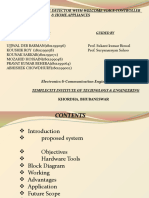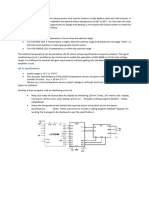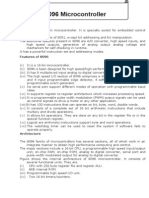IOPortProgramming Exercises
IOPortProgramming Exercises
Uploaded by
PragathishCopyright:
Available Formats
IOPortProgramming Exercises
IOPortProgramming Exercises
Uploaded by
PragathishOriginal Title
Copyright
Available Formats
Share this document
Did you find this document useful?
Is this content inappropriate?
Copyright:
Available Formats
IOPortProgramming Exercises
IOPortProgramming Exercises
Uploaded by
PragathishCopyright:
Available Formats
Write a program for the DS89C420 to toggle all the bits of P0, P1,
and P2 every 1/4 of a second
I/O ORG 0
PROGRAMMING BACK: MOV A,#55H
MOV P0,A
MOV P1,A
Port 3 MOV P2,A
ACALL QSDELAY ;Quarter of a second
(cont’) MOV A,#0AAH
MOV P0,A
MOV P1,A
MOV P2,A
ACALL QSDELAY
P1.0 1 40 Vcc SJMP BACK
P1.1 2 39 P0.0(AD0)
P1.2 3 38 P0.1(AD1) QSDELAY: Delay
P1.3 4 37 P0.2(AD2)
P1.4
P1.5
5
6
36
35
P0.3(AD3)
P0.4(AD4)
MOV R5,#11 = 11 × 248 × 255 × 4 MC × 90 ns
P1.6
P1.7
7
8
34
33
P0.5(AD5)
P0.6(AD6)
H3: MOV R4,#248 = 250,430 µs
RST 9 32 P0.7(AD7)
(RXD)P3.0 10
8051 31 -EA/VPP H2: MOV R3,#255
(TXD)P3.1 11(8031)30 ALE/PROG
(INT0)P3.2
(INT1)P3.3
12 29
28
-PSEN
P2.7(A15)
H1: DJNZ R3,H1 ;4 MC for DS89C4x0
13
(T0)P3.4
(T1)P3.5
14
15
27
26
P2.6(A14)
P2.5(A13)
DJNZ R4,H2
(WR)P3.6 16 25 P2.4(A12)
(RD)P3.7 17 24 P2.3(A11) DJNZ R5,H3
XTAL2 18 23 P2.2(A10)
XTAL1
GND
19
20
22
21
P2.1(A9)
P2.0(A8)
RET
END
Department of Computer Science and Information Engineering
HANEL National Cheng Kung University, TAIWAN 14
The entire 8 bits of Port 1 are accessed
BACK: MOV A,#55H
I/O MOV P1,A
PROGRAMMING ACALL
MOV
DELAY
A,#0AAH
MOV P1,A
Different ways ACALL
SJMP
DELAY
BACK
of Accessing
Entire 8 Bits Rewrite the code in a more efficient manner by accessing the port
directly without going through the accumulator
BACK: MOV P1,#55H
ACALL DELAY
MOV P1,#0AAH
ACALL DELAY
SJMP BACK
Another way of doing the same thing
MOV A,#55H
BACK: MOV P1,A
ACALL DELAY
CPL A
SJMP BACK
Department of Computer Science and Information Engineering
HANEL National Cheng Kung University, TAIWAN 15
Sometimes we need to access only 1
I/O BIT
MANIPULATION
or 2 bits of the port
PROGRAMMING BACK: CPL
ACALL
P1.2
DELAY
;complement P1.2
SJMP BACK
I/O Ports
and Bit ;another variation of the above program
AGAIN: SETB P1.2 ;set only P1.2
Addressability ACALL DELAY
CLR P1.2 ;clear only P1.2
ACALL DELAY
SJMP AGAIN P0 P1 P2 P3 Port Bit
P0.0 P1.0 P2.0 P3.0 D0
P0.1 P1.1 P2.1 P3.1 D1
P0.2 P1.2 P2.2 P3.2 D2
P0.3 P1.3 P2.3 P3.3 D3
P0.4 P1.4 P2.4 P3.4 D4
P0.5 P1.5 P2.5 P3.5 D5
P0.6 P1.6 P2.6 P3.6 D6
P0.7 P1.7 P2.7 P3.7 D7
Department of Computer Science and Information Engineering
HANEL National Cheng Kung University, TAIWAN 16
Example 4-2
Write the following programs.
I/O BIT Create a square wave of 50% duty cycle on bit 0 of port 1.
MANIPULATION Solution:
PROGRAMMING The 50% duty cycle means that the “on” and “off” state (or the high
and low portion of the pulse) have the same length. Therefore,
I/O Ports we toggle P1.0 with a time delay in between each state.
and Bit HERE: SETB P1.0 ;set to high bit 0 of port 1
LCALL DELAY ;call the delay subroutine
Addressability CLR P1.0 ;P1.0=0
(cont’) LCALL DELAY
SJMP HERE ;keep doing it
Another way to write the above program is:
HERE: CPL P1.0 ;set to high bit 0 of port 1
LCALL DELAY ;call the delay subroutine
SJMP HERE ;keep doing it
8051
P1.0
Department of Computer Science and Information Engineering
HANEL National Cheng Kung University, TAIWAN 17
Instructions that are used for signal-bit
I/O BIT
operations are as following
MANIPULATION
PROGRAMMING Single-Bit Instructions
Instruction Function
I/O Ports SETB bit Set the bit (bit = 1)
and Bit CLR bit Clear the bit (bit = 0)
Addressability CPL bit Complement the bit (bit = NOT bit)
(cont’) JB bit, target Jump to target if bit = 1 (jump if bit)
JNB bit, target Jump to target if bit = 0 (jump if no bit)
JBC bit, target Jump to target if bit = 1, clear bit
(jump if bit, then clear)
Department of Computer Science and Information Engineering
HANEL National Cheng Kung University, TAIWAN 18
The JNB and JB instructions are widely
I/O BIT used single-bit operations
MANIPULATION ¾ They allow you to monitor a bit and make
PROGRAMMING a decision depending on whether it’s 0 or 1
¾ These two instructions can be used for any
Checking an bits of I/O ports 0, 1, 2, and 3
Input Bit Port 3 is typically not used for any I/O, either
single-bit or byte-wise
Instructions for Reading an Input Port
Mnemonic Examples Description
MOV A,PX MOV A,P2 Bring into A the data at P2 pins
JNB PX.Y, .. JNB P2.1,TARGET Jump if pin P2.1 is low
JB PX.Y, .. JB P1.3,TARGET Jump if pin P1.3 is high
MOV C,PX.Y MOV C,P2.4 Copy status of pin P2.4 to CY
Department of Computer Science and Information Engineering
HANEL National Cheng Kung University, TAIWAN 19
Example 4-3
I/O BIT
Write a program to perform the following:
MANIPULATION (a) Keep monitoring the P1.2 bit until it becomes high
PROGRAMMING (b) When P1.2 becomes high, write value 45H to port 0
(c) Send a high-to-low (H-to-L) pulse to P2.3
Solution:
Checking an SETB P1.2 ;make P1.2 an input
Input Bit MOV A,#45H ;A=45H
(cont’) AGAIN: JNB P1.2,AGAIN ; get out when P1.2=1
MOV P0,A ;issue A to P0
SETB P2.3 ;make P2.3 high
CLR P2.3 ;make P2.3 low for H-to-L
Department of Computer Science and Information Engineering
HANEL National Cheng Kung University, TAIWAN 20
Example 4-4
I/O BIT
Assume that bit P2.3 is an input and represents the condition of an
MANIPULATION oven. If it goes high, it means that the oven is hot. Monitor the bit
PROGRAMMING continuously. Whenever it goes high, send a high-to-low pulse to port
P1.5 to turn on a buzzer.
Solution:
Checking an
HERE: JNB P2.3,HERE ;keep monitoring for high
Input Bit SETB P1.5 ;set bit P1.5=1
(cont’) CLR P1.5 ;make high-to-low
SJMP HERE ;keep repeating
Department of Computer Science and Information Engineering
HANEL National Cheng Kung University, TAIWAN 21
Example 4-5
I/O BIT
A switch is connected to pin P1.7. Write a program to check the status
MANIPULATION of SW and perform the following:
PROGRAMMING (a) If SW=0, send letter ‘N’ to P2
(b) If SW=1, send letter ‘Y’ to P2
Checking an Solution:
Input Bit
SETB P1.7 ;make P1.7 an input
AGAIN: JB P1.2,OVER ;jump if P1.7=1
(cont’)
MOV P2,#’N’ ;SW=0, issue ‘N’ to P2
SJMP AGAIN ;keep monitoring
OVER: MOV P2,#’Y’ ;SW=1, issue ‘Y’ to P2
SJMP AGAIN ;keep monitoring
Department of Computer Science and Information Engineering
HANEL National Cheng Kung University, TAIWAN 22
Example 4-6
I/O BIT
A switch is connected to pin P1.7. Write a program to check the status
MANIPULATION of SW and perform the following:
PROGRAMMING (a) If SW=0, send letter ‘N’ to P2
(b) If SW=1, send letter ‘Y’ to P2
Use the carry flag to check the switch status.
Reading Single Solution:
Bit into Carry SETB P1.7 ;make P1.7 an input
Flag AGAIN: MOV C,P1.2 ;read SW status into CF
JC OVER ;jump if SW=1
MOV P2,#’N’ ;SW=0, issue ‘N’ to P2
SJMP AGAIN ;keep monitoring
OVER: MOV P2,#’Y’ ;SW=1, issue ‘Y’ to P2
SJMP AGAIN ;keep monitoring
Department of Computer Science and Information Engineering
HANEL National Cheng Kung University, TAIWAN 23
Example 4-7
I/O BIT
A switch is connected to pin P1.0 and an LED to pin P2.7. Write a
MANIPULATION program to get the status of the switch and send it to the LED
PROGRAMMING
Solution:
SETB P1.7 ;make P1.7 an input
Reading Single AGAIN: MOV C,P1.0 ;read SW status into CF
Bit into Carry MOV P2.7,C ;send SW status to LED
Flag SJMP AGAIN ;keep repeating
(cont’)
The instruction
‘MOV
P2.7,P1.0’ is
wrong , since such
However ‘MOV an instruction does
P2,P1’ is a valid not exist
instruction
Department of Computer Science and Information Engineering
HANEL National Cheng Kung University, TAIWAN 24
In reading a port
I/O BIT ¾ Some instructions read the status of port
MANIPULATION pins
PROGRAMMING ¾ Others read the status of an internal port
latch
Reading Input Therefore, when reading ports there
Pins vs. Port are two possibilities:
Latch ¾ Read the status of the input pin
¾ Read the internal latch of the output port
Confusion between them is a major
source of errors in 8051 programming
¾ Especially where external hardware is
concerned
Department of Computer Science and Information Engineering
HANEL National Cheng Kung University, TAIWAN 25
Some instructions read the contents of
READING
INPUT PINS VS.
an internal port latch instead of
PORT LATCH reading the status of an external pin
¾ For example, look at the ANL P1,A
Reading Latch instruction and the sequence of actions is
for Output Port executed as follow
1. It reads the internal latch of the port and
brings that data into the CPU
2. This data is ANDed with the contents of
register A
3. The result is rewritten back to the port latch
4. The port pin data is changed and now has the
same value as port latch
Department of Computer Science and Information Engineering
HANEL National Cheng Kung University, TAIWAN 26
Read-Modify-Write
READING
¾ The instructions read the port latch
INPUT PINS VS.
normally read a value, perform an
PORT LATCH operation then rewrite it back to the port
latch
Reading Latch Instructions Reading a latch (Read-Modify-Write)
for Output Port Mnemonics Example
(cont’) ANL PX ANL P1,A
ORL PX ORL P2,A
XRL PX XRL P0,A
JBC PX.Y,TARGET JBC P1.1,TARGET
CPL PX.Y CPL P1.2
INC PX INC P1
DEC PX DEC P2
DJNZ PX.Y,TARGET DJNZ P1,TARGET
MOV PX.Y,C MOV P1.2,C
CLR PX.Y CLR P2.3 Note: x is 0, 1, 2,
SETB PX.Y SETB P2.3 or 3 for P0 – P3
Department of Computer Science and Information Engineering
HANEL National Cheng Kung University, TAIWAN 27
The ports in 8051 can be accessed by
I/O BIT
MANIPULATION the Read-modify-write technique
PROGRAMMING ¾ This feature saves many lines of code by
combining in a single instruction all three
Read-modify- actions
write Feature 1. Reading the port
2. Modifying it
3. Writing to the port
MOV P1,#55H ;P1=01010101
AGAIN: XRL P1,#0FFH ;EX-OR P1 with 1111 1111
ACALL DELAY
SJMP BACK
Department of Computer Science and Information Engineering
HANEL National Cheng Kung University, TAIWAN 28
You might also like
- Contactless Digital Tachometer Using 8051Document3 pagesContactless Digital Tachometer Using 8051Muhammad JunaidNo ratings yet
- 8051 Assembly Language ExamDocument10 pages8051 Assembly Language ExamEvliya ÜlkerNo ratings yet
- ServiceManual For Data Communication EUDocument3 pagesServiceManual For Data Communication EUAshan JayawardenaNo ratings yet
- Block Diagram: Pin Description of The 8051Document2 pagesBlock Diagram: Pin Description of The 8051mohanNo ratings yet
- Microcontroller 8051Document13 pagesMicrocontroller 8051Emon RoyNo ratings yet
- IO PortsDocument27 pagesIO Portskiranpawarindia1234No ratings yet
- 89C51Document15 pages89C51Bhasker GurramNo ratings yet
- Microcontroller Lab Manual (10ESL47) BY RAGHUNATHDocument87 pagesMicrocontroller Lab Manual (10ESL47) BY RAGHUNATHRaghunath B HNo ratings yet
- External Interrupt Stepper Motor PDFDocument5 pagesExternal Interrupt Stepper Motor PDFJashwanth saiNo ratings yet
- 8-Bit Microcontroller With 4 Kbytes Flash: FeaturesDocument16 pages8-Bit Microcontroller With 4 Kbytes Flash: FeaturesJose Chepo Manuel HNo ratings yet
- CH 4Document16 pagesCH 4Oussama SamirNo ratings yet
- Chapter 4: Input/Output Programming of 8051 CPUDocument7 pagesChapter 4: Input/Output Programming of 8051 CPUIsmailNo ratings yet
- The 8051 Microcontroller & Embedded Systems: Muhammad Ali Mazidi, Janice Mazidi & Rolin MckinlayDocument20 pagesThe 8051 Microcontroller & Embedded Systems: Muhammad Ali Mazidi, Janice Mazidi & Rolin MckinlayAkshwin KisoreNo ratings yet
- L4 - Simple I - O ControlDocument9 pagesL4 - Simple I - O ControlDilip KenNo ratings yet
- COI2 Interfacing With 8051Document44 pagesCOI2 Interfacing With 8051HiNo ratings yet
- MP & MC Module-4Document72 pagesMP & MC Module-4jeezNo ratings yet
- Special Function RegistersDocument7 pagesSpecial Function RegistersAbhradeepNo ratings yet
- The 8051 Microcontroller: Prepared By, R-Thandaiah Prabu M.E., Lecturer - ECEDocument46 pagesThe 8051 Microcontroller: Prepared By, R-Thandaiah Prabu M.E., Lecturer - ECESuresh ChinthaNo ratings yet
- MM Unit VDocument52 pagesMM Unit Vkrishnavenibonala04No ratings yet
- Unit 2 Architecture of 8051 MicrocontrollerDocument25 pagesUnit 2 Architecture of 8051 Microcontrolleranil sonawaneNo ratings yet
- AT89C51 Data SheetDocument17 pagesAT89C51 Data SheetrishindiaNo ratings yet
- Basic Aplication InOut With mCS51Document9 pagesBasic Aplication InOut With mCS51itmyNo ratings yet
- Manual Simple Trainer 8051Document6 pagesManual Simple Trainer 8051Sumarwan WawanNo ratings yet
- Disadvantages of MicroprocessorDocument37 pagesDisadvantages of MicroprocessorGayathriRajiNo ratings yet
- Interfacing 8051 With LCDDocument8 pagesInterfacing 8051 With LCDUmair HameedNo ratings yet
- Datasheet PDFDocument28 pagesDatasheet PDFArlen FonsecaNo ratings yet
- ElectrogoniometerDocument17 pagesElectrogoniometerGaurav MolankarNo ratings yet
- Embedded Systems AssignmentDocument7 pagesEmbedded Systems AssignmentZainNo ratings yet
- Technical - PCB 100 MAIN 10 - 2013 08 30Document4 pagesTechnical - PCB 100 MAIN 10 - 2013 08 30Robson BarrosNo ratings yet
- Water Level IndicatorDocument11 pagesWater Level Indicatornik_n_89100% (2)
- Lab Reort # 6: TITLE: Serial Communication Between Microcontrollers. Components RequiredDocument5 pagesLab Reort # 6: TITLE: Serial Communication Between Microcontrollers. Components RequiredziaNo ratings yet
- At89c52 Instruction SetDocument22 pagesAt89c52 Instruction SetaposticaaNo ratings yet
- 8051 With SwitchDocument10 pages8051 With SwitchespoirbondoNo ratings yet
- 8-Bit Microcontroller With 8K Bytes Quickflash At87F52: FeaturesDocument24 pages8-Bit Microcontroller With 8K Bytes Quickflash At87F52: FeaturesANILNo ratings yet
- Microcontroller (8051) - A Short DescriptionDocument10 pagesMicrocontroller (8051) - A Short DescriptionsiddharthNo ratings yet
- 8-Bit Microcontroller With 8K Bytes In-System Programmable Flash AT89LP52 - PreliminaryDocument113 pages8-Bit Microcontroller With 8K Bytes In-System Programmable Flash AT89LP52 - PreliminaryVella GamingNo ratings yet
- 8-Bit Microcontroller With 8K Bytes Flash AT89C52: FeaturesDocument23 pages8-Bit Microcontroller With 8K Bytes Flash AT89C52: FeaturesvbaixistaNo ratings yet
- xc400x PinoutDocument40 pagesxc400x PinoutJuan CarlosNo ratings yet
- 20EC3352 LAB EXPERIMENTS OldDocument47 pages20EC3352 LAB EXPERIMENTS Oldswathi kesanaNo ratings yet
- AT87C51Document16 pagesAT87C51flo724No ratings yet
- Lab Report 02Document8 pagesLab Report 02prasapereraNo ratings yet
- Lecture #09Document8 pagesLecture #09Abdo HeshamNo ratings yet
- Org 00HDocument4 pagesOrg 00HINt LiGaNo ratings yet
- MICRO CONTROLLER LAB ManualDocument33 pagesMICRO CONTROLLER LAB ManualSrikanth ImmaReddyNo ratings yet
- 8-Bit Microcontroller With 32K Bytes Flash AT89C51RC: FeaturesDocument38 pages8-Bit Microcontroller With 32K Bytes Flash AT89C51RC: FeaturesCarlos GalvisNo ratings yet
- 8051 MicrocontrollerDocument39 pages8051 MicrocontrollerSandesh patilNo ratings yet
- MX10E8050IDocument41 pagesMX10E8050IvetchboyNo ratings yet
- Keyboard InterfacingDocument15 pagesKeyboard Interfacingdarshit1989No ratings yet
- 8051 Atmel DatasheetDocument12 pages8051 Atmel Datasheetpranav_c22100% (3)
- 89c51 - Projectboard - Circuit DiagramDocument2 pages89c51 - Projectboard - Circuit DiagramNirmal Vinu100% (1)
- Vivekananda Samantra CP15 05 01-Embedded SystemsDocument85 pagesVivekananda Samantra CP15 05 01-Embedded Systems3044vivekNo ratings yet
- HarshaDocument14 pagesHarshaUjjwal Deb BarmanNo ratings yet
- Tutorials On 8051Document10 pagesTutorials On 8051DuoDrenchNo ratings yet
- Description of UcDocument29 pagesDescription of UcPraveen SinghNo ratings yet
- Lecture 1Document89 pagesLecture 1Kalpana ParabNo ratings yet
- Projects With Microcontrollers And PICCFrom EverandProjects With Microcontrollers And PICCRating: 5 out of 5 stars5/5 (1)
- Casestudy 1Document4 pagesCasestudy 1PragathishNo ratings yet
- Data Transfer, SortingDocument3 pagesData Transfer, SortingPragathishNo ratings yet
- Data TransferDocument4 pagesData TransferPragathishNo ratings yet
- Microcontroller NotesDocument154 pagesMicrocontroller NotesPragathishNo ratings yet
- Grade7 Q0 W4 PerformMensuration for-STUDENTDocument32 pagesGrade7 Q0 W4 PerformMensuration for-STUDENTMICHAEL USTARENo ratings yet
- AbbreviationsDocument3 pagesAbbreviationsAsadkhannNo ratings yet
- PAC1710 20 Data SheetDocument48 pagesPAC1710 20 Data SheetBurakcan GuvenirNo ratings yet
- Computer Awareness Question BankDocument83 pagesComputer Awareness Question BankDev Dutt SharmaNo ratings yet
- PoscoDocument6 pagesPoscoJoel Guerrero MartinezNo ratings yet
- Cellocator Integration Practical ExamplesDocument24 pagesCellocator Integration Practical ExamplesYosef GUEVARA SALAMANCANo ratings yet
- Practical 1Document13 pagesPractical 1swan htetpyNo ratings yet
- Quiz 3 SolutionDocument4 pagesQuiz 3 SolutionLabson JohnNo ratings yet
- Computer: 5 Generations of ComputersDocument6 pagesComputer: 5 Generations of ComputersAayush AroraNo ratings yet
- Coding and Multi-UserDocument35 pagesCoding and Multi-Userhendra lamNo ratings yet
- Computer Organization Jul 2008 OldDocument1 pageComputer Organization Jul 2008 OldPrasad C MNo ratings yet
- 1.eastron SDM230-2T Smart Meter Modbus Protocol Implementation V1.1Document20 pages1.eastron SDM230-2T Smart Meter Modbus Protocol Implementation V1.1Ronald N Meza CNo ratings yet
- Quick Guide To CFI AnDocument13 pagesQuick Guide To CFI AnKatarina SreckovicNo ratings yet
- 8096Document23 pages8096Sreekanth Pagadapalli50% (2)
- Microprocessor Complete 1Document56 pagesMicroprocessor Complete 1Diwakar ShresthaNo ratings yet
- Signed Binary Numbers and Two's Complement NumbersDocument8 pagesSigned Binary Numbers and Two's Complement NumbersVansh BansalNo ratings yet
- 1.3 Data Storage Lectures SlidesDocument14 pages1.3 Data Storage Lectures SlidesdapotatogamerzNo ratings yet
- Allenbradley DHPDocument69 pagesAllenbradley DHPsc13701100% (1)
- An3163 Application Note: Configuring Your Iso 15693 Reader To Support The M24Lrxx-R and M24Lrxxe-R DevicesDocument13 pagesAn3163 Application Note: Configuring Your Iso 15693 Reader To Support The M24Lrxx-R and M24Lrxxe-R DevicesFan YueNo ratings yet
- Product Information On The Reference Manual: 1 Position Decoder Module SM 338 POS-INPUT (6ES7338-4BC01-0AB0)Document18 pagesProduct Information On The Reference Manual: 1 Position Decoder Module SM 338 POS-INPUT (6ES7338-4BC01-0AB0)Deny Tirta KusumaNo ratings yet
- Xilinx Programmer Qualification Specification: DescriptionDocument16 pagesXilinx Programmer Qualification Specification: DescriptionsaikumarNo ratings yet
- 2022 First Term Mr. EneojoDocument16 pages2022 First Term Mr. EneojoEneojo DanielNo ratings yet
- Single-Edge Nibble Transmission (SENT) Module: HighlightsDocument24 pagesSingle-Edge Nibble Transmission (SENT) Module: Highlightsvinoth1983mu6050No ratings yet
- Message Configuration For TD 200 Using STEP 7-MicroDocument3 pagesMessage Configuration For TD 200 Using STEP 7-Microwww.otomasyonegitimi.comNo ratings yet
- Guida Tecnica: Technical Guide:: Regolatore Digitale DER1 DER1 Digital RegulatorDocument34 pagesGuida Tecnica: Technical Guide:: Regolatore Digitale DER1 DER1 Digital RegulatorPablo Gaspar D'Agostini AmengualNo ratings yet
- Assembly Language For Intel-Based Computers, 4 Edition Boolean and Comparison InstructionsDocument14 pagesAssembly Language For Intel-Based Computers, 4 Edition Boolean and Comparison InstructionsSin Jie LimNo ratings yet
- New BGL File Structure PDFDocument29 pagesNew BGL File Structure PDFSergio Andres Orduz OrduzNo ratings yet
- Handnote 1 Chap 1Document2 pagesHandnote 1 Chap 1Muhammad HossainNo ratings yet
- 2-1 Digital Tech I 08 v1Document196 pages2-1 Digital Tech I 08 v1Abiyot AderieNo ratings yet





























































































